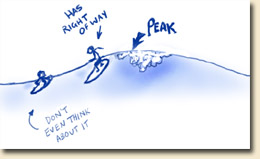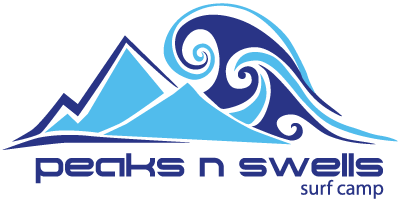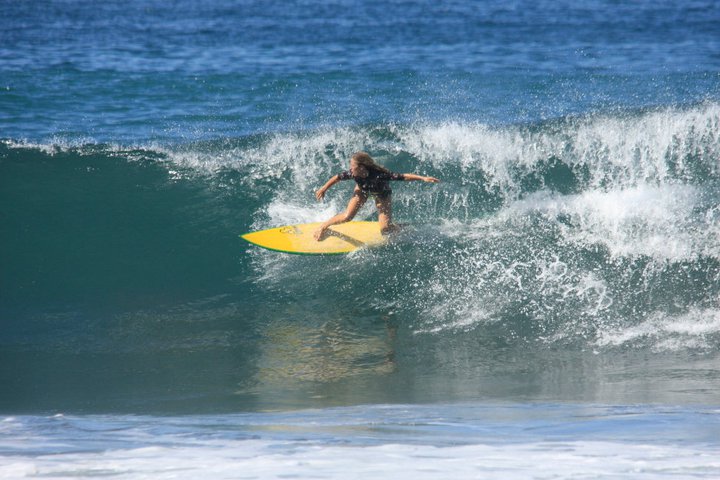So, you’ve spent a week at surf camp. You’ve mastered the pop-up, paddled till you couldn’t feel your arms, learned the all-important turtle roll, and caught your first-ever green wave…and you’re in love. Maybe you’re even thinking about swapping your beach chair for a surfboard this summer? We’re not going to lie to you, it’s a lot easier to catch great waves with a seasoned coach in the water next to you helping you pick and time your wave. But you can do this! You’ve got all the skills you need to get out there. In case you’re feeling a little rusty, we’ve put together this list of tips and reminders to help you get your surf on this summer. Be confident, be careful and, most important, have fun. You’re a surfer now!
- Maintain muscle memory. Unless you’re surfing regularly, chances are you discovered some new muscles during your week at camp. Surfing, like so many sports, is really about core strength. Doing a few sets of basic sit-ups and push-ups everyday will help you maintain paddling and pop-up strength. Yoga also targets a lot of the critical posterior muscle groups needed for strong surfing, so try to throw in a weekly class if you can. Click here for a few more workout tips from our lovely surf coach emeritus, Gem Yates.
- Master the pop-up. Remember how your coach drew a cross in the sand and had you practice popping up? Good news! You can do that anywhere. Use tape to draw a cross on the floor and position your body along the vertical line. Your hands should be on the horizontal line near your rib cage. When you pop up, both feet should land on the vertical line, with your front foot smack in the center of the cross. Do this every day and you won’t even have to think about it on the water…plus you’ll be building core and upper body strength.
- Check conditions. Surfline and Magic Seaweed are both good resources for checking conditions. What to look for: A nice offshore breeze will help the waves stand up a little taller and prevent conditions from becoming choppy. You also want to look for longer wave intervals (10 seconds or more), which will make for a more organized and higher quality wave. Surf height is also really important. A 2-4′ surf report means waves will be knee to chest high. 5-6′ means head high. Anything over that and you’re looking at some pretty big surf. Most conditions reports will also include a nice, easy to read star system to make life a little easier for you.
- Positioning. When you get to the break, check out where the local surfers are in the water, and where they’re catching waves. This is where you want to be, but remember your etiquette. You don’t want to introduce yourself by dropping in on someone else’s wave.
 Etiquette. Speaking of dropping in, the surfer closest to the peak of the wave (where it is starting to break) has the right of way over the surfer who is father out on the shoulder of the wave. However, etiquette also dictates that the first person standing on the wave has the right of way over others who are still paddling. It can get a little hectic at a crowded break, so take the time to understand etiquette before you head out. This post from The Surfing Handbook has some really good information.
Etiquette. Speaking of dropping in, the surfer closest to the peak of the wave (where it is starting to break) has the right of way over the surfer who is father out on the shoulder of the wave. However, etiquette also dictates that the first person standing on the wave has the right of way over others who are still paddling. It can get a little hectic at a crowded break, so take the time to understand etiquette before you head out. This post from The Surfing Handbook has some really good information.
- Paddle. Hard. Those last few strokes as you paddle into the wave are the most important. Don’t give up…usually 2-3 additional strokes will get you up and riding that wave.
- Look where you want to go. Your body (and your surfboard) will follow your eyes, so always look to where you want to be on the wave.
- Watch surf videos. Rainy day got you inside? Check out our list of the Best Surf Movies on YouTube. Watching accomplished surfers really does help understand the mechanics of surfing, plus it’s pretty darn inspiring.
- Go for it! The surfer catching the most waves is usually the one going for the most waves. Don’t be afraid to give it a go! The surfing community is generally a pretty supportive and friendly crew, so get out there this summer and have some fun. And drop us a line or send a photo. We love to see PNS alum out there surfing all over the world.

